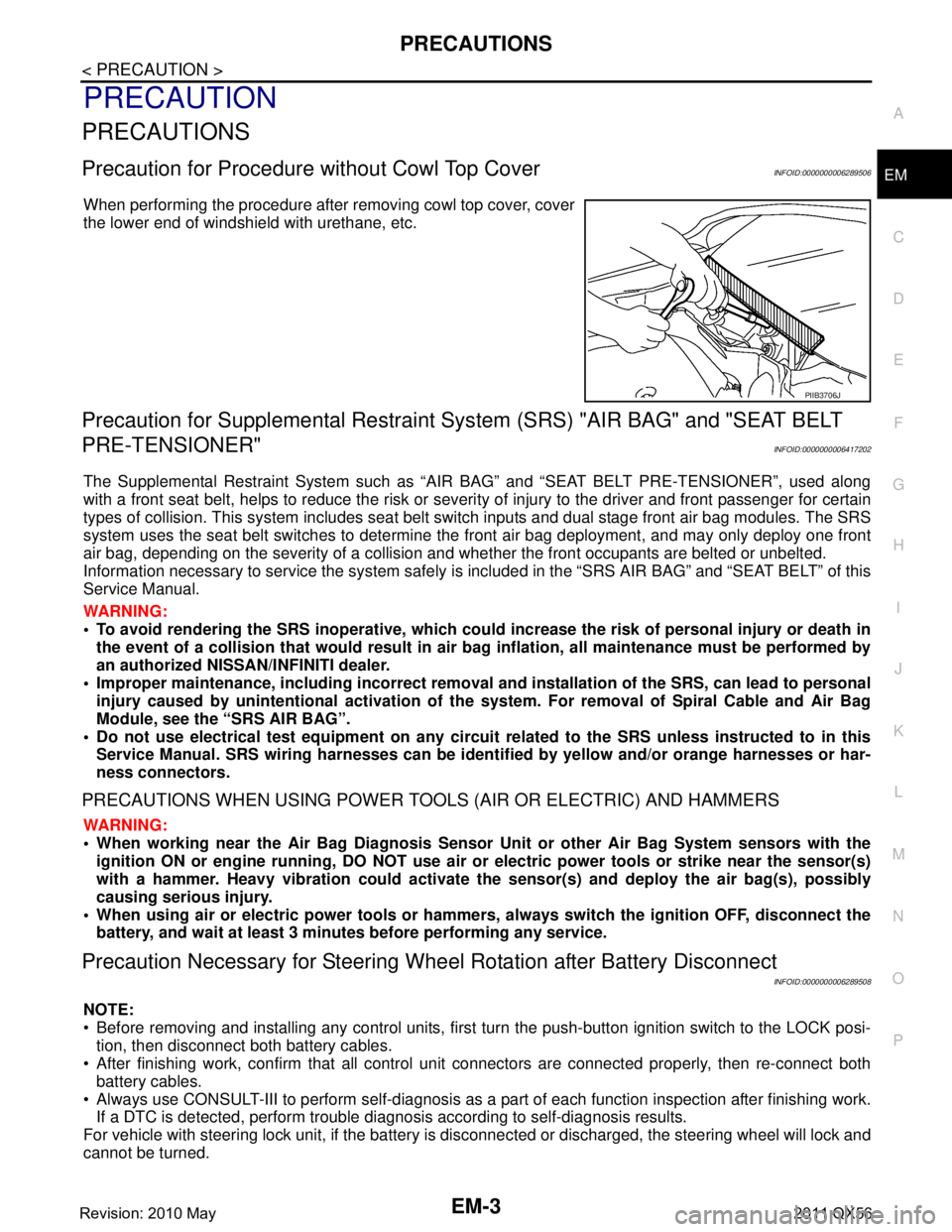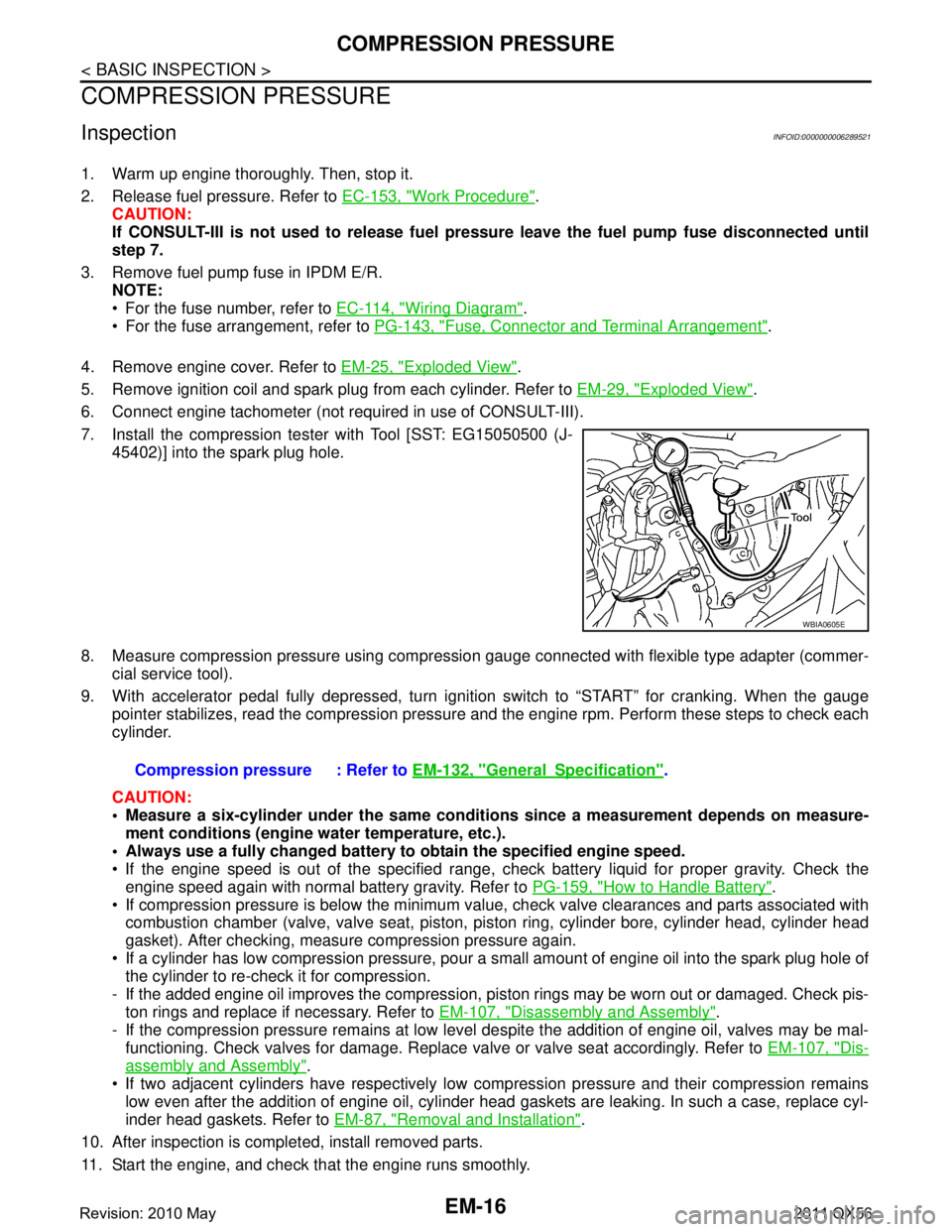2011 INFINITI QX56 wiring
[x] Cancel search: wiringPage 2534 of 5598
![INFINITI QX56 2011 Factory Service Manual
EC-510
< DTC/CIRCUIT DIAGNOSIS >[VK56VD]
IGNITION SIGNAL
3. Remove fuel pump fuse in IPDM E/R to release fuel pressure.
NOTE:
For the fuse number, refer to EC-114, "
Wiring Diagram".
For the fus INFINITI QX56 2011 Factory Service Manual
EC-510
< DTC/CIRCUIT DIAGNOSIS >[VK56VD]
IGNITION SIGNAL
3. Remove fuel pump fuse in IPDM E/R to release fuel pressure.
NOTE:
For the fuse number, refer to EC-114, "
Wiring Diagram".
For the fus](/manual-img/42/57033/w960_57033-2533.png)
EC-510
< DTC/CIRCUIT DIAGNOSIS >[VK56VD]
IGNITION SIGNAL
3. Remove fuel pump fuse in IPDM E/R to release fuel pressure.
NOTE:
For the fuse number, refer to EC-114, "
Wiring Diagram".
For the fuse arrangement, refer to PG-143, "
Fuse, Connector and Terminal Arrangement".
Do not use CONSULT-III to release fuel pressure , or fuel pressure applies again during the following
procedure.
4. Start engine.
5. After engine stalls, crank it 2 or 3 times to release all fuel pressure.
6. Turn ignition switch OFF.
7. Remove all ignition coil harness connectors to avoi d the electrical discharge from the ignition coils.
8. Remove ignition coil and spark plug of the cylinder to be checked.
9. Crank engine for 5 seconds or more to remove combustion gas in the cylinder.
10. Connect spark plug and harness connector to ignition coil.
11. Fix ignition coil using a rope etc. with gap of 13 - 17 mm (0.52 - 0.66 in) between the edge of the spark plug and grounded metal
portion as shown in the figure.
12. Crank engine for approximately 3 seconds, and check whether
spark is generated between the spark plug and the grounded
metal portion.
CAUTION:
Never place the spark plug and the ignition coil within 50
cm (19.7 in) each other. Be careful not to get an electrical
shock while checking, becau se the electrical discharge
voltage becomes 20 kV or more.
It might damage the ignition coil if the gap of more than 17 mm (0.66 in) is made.
NOTE:
When the gap is less than 13 mm (0.52 in), a spark might be generated even if the coil is malfunc-
tioning.
Is the inspection result normal?
YES >> INSPECTION END
NO >> Replace malfunctioning ignition coil with power transistor.
Component Inspection (Condenser)INFOID:0000000006218014
1.CHECK CONDENSER
1. Turn ignition switch OFF.
2. Disconnect condenser harness connector.
3. Check resistance between condenser terminals as per the following.
Is the inspection result normal?
YES >> INSPECTION END
NO >> Replace condenser. Spark should be generated.
JMBIA0066GB
Terminals Resistance
1 and 2 Above 1 M Ω [at 25 °C (77 °F)]
Revision: 2010 May2011 QX56
Page 2565 of 5598

PRECAUTIONSEM-3
< PRECAUTION >
C
DE
F
G H
I
J
K L
M A
EM
NP
O
PRECAUTION
PRECAUTIONS
Precaution for Procedur
e without Cowl Top CoverINFOID:0000000006289506
When performing the procedure after removing cowl top cover, cover
the lower end of windshield with urethane, etc.
Precaution for Supplemental Restraint System (SRS) "AIR BAG" and "SEAT BELT
PRE-TENSIONER"
INFOID:0000000006417202
The Supplemental Restraint System such as “A IR BAG” and “SEAT BELT PRE-TENSIONER”, used along
with a front seat belt, helps to reduce the risk or severi ty of injury to the driver and front passenger for certain
types of collision. This system includes seat belt switch inputs and dual stage front air bag modules. The SRS
system uses the seat belt switches to determine the front air bag deployment, and may only deploy one front
air bag, depending on the severity of a collision and whether the front occupants are belted or unbelted.
Information necessary to service the system safely is included in the “SRS AIR BAG” and “SEAT BELT” of this
Service Manual.
WARNING:
• To avoid rendering the SRS inoper ative, which could increase the risk of personal injury or death in
the event of a collision that would result in air ba g inflation, all maintenance must be performed by
an authorized NISSAN/INFINITI dealer.
Improper maintenance, including in correct removal and installation of the SRS, can lead to personal
injury caused by unintentional act ivation of the system. For removal of Spiral Cable and Air Bag
Module, see the “SRS AIR BAG”.
Do not use electrical test equipm ent on any circuit related to the SRS unless instructed to in this
Service Manual. SRS wiring harnesses can be identi fied by yellow and/or orange harnesses or har-
ness connectors.
PRECAUTIONS WHEN USING POWER TOOLS (AIR OR ELECTRIC) AND HAMMERS
WARNING:
When working near the Air Bag Diagnosis Sensor Unit or other Air Bag System sensors with the
ignition ON or engine running, DO NOT use air or electric power tools or strike near the sensor(s)
with a hammer. Heavy vibration could activate the sensor(s) and deploy the air bag(s), possibly
causing serious injury.
When using air or electric power tools or hammers , always switch the ignition OFF, disconnect the
battery, and wait at least 3 minutes before performing any service.
Precaution Necessary for Steering Wh eel Rotation after Battery Disconnect
INFOID:0000000006289508
NOTE:
Before removing and installing any control units, first tu rn the push-button ignition switch to the LOCK posi-
tion, then disconnect both battery cables.
After finishing work, confirm that all control unit connectors are connected properly, then re-connect both
battery cables.
Always use CONSULT-III to perform self-diagnosis as a part of each function inspection after finishing work.
If a DTC is detected, perform trouble diagnos is according to self-diagnosis results.
For vehicle with steering lock unit, if the battery is disconnected or discharged, the steering wheel will lock and
cannot be turned.
PIIB3706J
Revision: 2010 May2011 QX56
Page 2578 of 5598

EM-16
< BASIC INSPECTION >
COMPRESSION PRESSURE
COMPRESSION PRESSURE
InspectionINFOID:0000000006289521
1. Warm up engine thoroughly. Then, stop it.
2. Release fuel pressure. Refer to EC-153, "
Work Procedure".
CAUTION:
If CONSULT-III is not used to release fuel pr essure leave the fuel pump fuse disconnected until
step 7.
3. Remove fuel pump fuse in IPDM E/R. NOTE:
For the fuse number, refer to EC-114, "
Wiring Diagram".
For the fuse arrangement, refer to PG-143, "
Fuse, Connector and Terminal Arrangement".
4. Remove engine cover. Refer to EM-25, "
Exploded View".
5. Remove ignition coil and spark plug from each cylinder. Refer to EM-29, "
Exploded View".
6. Connect engine tachometer (not required in use of CONSULT-III).
7. Install the compression tester with Tool [SST: EG15050500 (J- 45402)] into the spark plug hole.
8. Measure compression pressure using compressi on gauge connected with flexible type adapter (commer-
cial service tool).
9. With accelerator pedal fully depressed, turn ignition switch to “START” for cranking. When the gauge pointer stabilizes, read the compression pressure and the engine rpm. Perform these steps to check each
cylinder.
CAUTION:
Measure a six-cylinder under the same conditio ns since a measurement depends on measure-
ment conditions (engine water temperature, etc.).
Always use a fully changed battery to obtain the specified engine speed.
If the engine speed is out of the specified range, c heck battery liquid for proper gravity. Check the
engine speed again with normal battery gravity. Refer to PG-159, "
How to Handle Battery".
If compression pressure is below the minimum value, check valve clearances and parts associated with combustion chamber (valve, valve seat, piston, pi ston ring, cylinder bore, cylinder head, cylinder head
gasket). After checking, measure compression pressure again.
If a cylinder has low compression pressure, pour a small amount of engine oil into the spark plug hole of the cylinder to re-check it for compression.
- If the added engine oil improves the compression, pi ston rings may be worn out or damaged. Check pis-
ton rings and replace if necessary. Refer to EM-107, "
Disassembly and Assembly".
- If the compression pressure remains at low level despite the addition of engine oil, valves may be mal- functioning. Check valves for damage. Replace valve or valve seat accordingly. Refer to EM-107, "
Dis-
assembly and Assembly".
If two adjacent cylinders have respectively low co mpression pressure and their compression remains
low even after the addition of engine oil, cylinder head gaskets are leaking. In such a case, replace cyl-
inder head gaskets. Refer to EM-87, "
Removal and Installation".
10. After inspection is completed, install removed parts.
11. Start the engine, and check that the engine runs smoothly.
WBIA0605E
Compression pressure : Refer to EM-132, "GeneralSpecification".
Revision: 2010 May2011 QX56
Page 2712 of 5598

EXL-2
EXTERIOR LAMP BATTERY SAVER SYSTEM :
System Description .................................................
21
DIAGNOSIS SYSTEM (BCM) ............................22
COMMON ITEM ..................................................... ...22
COMMON ITEM : CONSULT-III Function (BCM -
COMMON ITEM) ................................................. ...
22
HEADLAMP ........................................................... ...23
HEADLAMP : CONSULT-III Function (BCM -
HEAD LAMP) ..........................................................
23
FLASHER ............................................................... ...25
FLASHER : CONSULT-III Function (BCM -
FLASHER) ..............................................................
25
DIAGNOSIS SYSTEM (IPDM E/R) ....................27
Diagnosis Description .......................................... ...27
CONSULT-III Function (IPDM E/R) ........................29
DIAGNOSIS SYSTEM (AFS) .............................32
CONSULT-III Function (ADAPTIVE LIGHT) ........ ...32
ECU DIAGNOSIS INFORMATION ..............34
BCM, IPDM E/R .............................................. ...34
List of ECU Reference ......................................... ...34
AFS CONTROL UNIT ........................................35
Reference Value .................................................. ...35
Fail-Safe .................................................................38
DTC Inspection Priority Chart .................................39
DTC Index ..............................................................39
WIRING DIAGRAM .....................................40
EXTERIOR LIGHTING SYSTEM .................... ...40
Wiring Diagram .................................................... ...40
BASIC INSPECTION ...................................59
DIAGNOSIS AND REPAIR WORKFLOW ...... ...59
Work Flow ............................................................ ...59
INSPECTION AND ADJUSTMENT ...................61
ADDITIONAL SERVICE WHEN REPLACING
CONTROL UNIT (AFS CONTROL UNIT) .............. ...
61
ADDITIONAL SERVICE WHEN REPLACING
CONTROL UNIT (AFS CONTROL UNIT) : De-
scription ..................................................................
61
ADDITIONAL SERVICE WHEN REPLACING
CONTROL UNIT (AFS CONTROL UNIT) : Special
Repair Requirement ...............................................
61
ADDITIONAL SERVICE WHEN REPLACING
CONTROL UNIT (HEIGHT SENSOR) ................... ...
61
ADDITIONAL SERVICE WHEN REPLACING
CONTROL UNIT (HEIGHT SENSOR) : Descrip-
tion ....................................................................... ...
61
ADDITIONAL SERVICE WHEN REPLACING
CONTROL UNIT (HEIGHT SENSOR) : Special
Repair Requirement ............................................. ...
61
LEVELIZER ADJUSTMENT ......................................61
LEVELIZER ADJUSTMENT : Description ..............61
LEVELIZER ADJUSTMENT : Special Repair Re-
quirement ............................................................. ...
61
DTC/CIRCUIT DIAGNOSIS ........................63
B2503, B2504 SWIVEL ACTUATOR ............. ...63
DTC Logic ............................................................ ...63
Diagnosis Procedure ...............................................64
Component Inspection ............................................67
B2513 HEIGHT SENSOR UNUSUAL [FR] .......68
DTC Logic ............................................................ ...68
Diagnosis Procedure ...............................................68
B2514 HEIGHT SENSOR UNUSUAL [RR] .......71
DTC Logic ............................................................ ...71
Diagnosis Procedure ...............................................71
B2516 SHIFT SIGNAL [P, R] ............................74
DTC Logic ............................................................ ...74
Diagnosis Procedure ...............................................74
B2517 VEHICLE SPEED SIGNAL ....................75
DTC Logic ............................................................ ...75
Diagnosis Procedure ...............................................75
B2519 LEVELIZER CALIBRATION ..................76
DTC Logic ............................................................ ...76
Diagnosis Procedure ...............................................76
B2521 ECU CIRCUIT ........................................77
DTC Logic ............................................................ ...77
Diagnosis Procedure ...............................................77
C0126 STEERING ANGLE SENSOR SIGNAL ...80
DTC Logic ............................................................ ...80
Diagnosis Procedure ...............................................80
C0428 STEERING ANGLE SENSOR CALI-
BRATION ...........................................................
81
DTC Logic ............................................................ ...81
Diagnosis Procedure ...............................................81
U1000 CAN COMM CIRCUIT ............................82
Description ........................................................... ...82
DTC Logic ...............................................................82
Diagnosis Procedure ...............................................82
U1010 CONTROL UNIT (CAN) .........................83
DTC Logic ............................................................ ...83
Diagnosis Procedure ...............................................83
POWER SUPPLY AND GROUND CIRCUIT .....84
AFS CONTROL UNIT ............................................. ...84
AFS CONTROL UNIT : Diagnosis Procedure .........84
Revision: 2010 May2011 QX56
Page 2715 of 5598
![INFINITI QX56 2011 Factory Service Manual
PRECAUTIONSEXL-5
< PRECAUTION > [XENON TYPE]
C
D
E
F
G H
I
J
K
M A
B
EXL
N
O P
PRECAUTION
PRECAUTIONS
Precaution for Supplemental Restraint System (SRS) "AIR BAG" and "SEAT BELT
PRE-TENSIONER"
INFO INFINITI QX56 2011 Factory Service Manual
PRECAUTIONSEXL-5
< PRECAUTION > [XENON TYPE]
C
D
E
F
G H
I
J
K
M A
B
EXL
N
O P
PRECAUTION
PRECAUTIONS
Precaution for Supplemental Restraint System (SRS) "AIR BAG" and "SEAT BELT
PRE-TENSIONER"
INFO](/manual-img/42/57033/w960_57033-2714.png)
PRECAUTIONSEXL-5
< PRECAUTION > [XENON TYPE]
C
D
E
F
G H
I
J
K
M A
B
EXL
N
O P
PRECAUTION
PRECAUTIONS
Precaution for Supplemental Restraint System (SRS) "AIR BAG" and "SEAT BELT
PRE-TENSIONER"
INFOID:0000000006450052
The Supplemental Restraint System such as “A IR BAG” and “SEAT BELT PRE-TENSIONER”, used along
with a front seat belt, helps to reduce the risk or severi ty of injury to the driver and front passenger for certain
types of collision. This system includes seat belt switch inputs and dual stage front air bag modules. The SRS
system uses the seat belt switches to determine the front air bag deployment, and may only deploy one front
air bag, depending on the severity of a collision and whether the front occupants are belted or unbelted.
Information necessary to service the system safely is included in the “SRS AIR BAG” and “SEAT BELT” of this
Service Manual.
WARNING:
• To avoid rendering the SRS inoper ative, which could increase the risk of personal injury or death in
the event of a collision that would result in air ba g inflation, all maintenance must be performed by
an authorized NISSAN/INFINITI dealer.
Improper maintenance, including in correct removal and installation of the SRS, can lead to personal
injury caused by unintentional act ivation of the system. For removal of Spiral Cable and Air Bag
Module, see the “SRS AIR BAG”.
Do not use electrical test equipm ent on any circuit related to the SRS unless instructed to in this
Service Manual. SRS wiring harnesses can be identi fied by yellow and/or orange harnesses or har-
ness connectors.
PRECAUTIONS WHEN USING POWER TOOLS (AIR OR ELECTRIC) AND HAMMERS
WARNING:
When working near the Air Bag Diagnosis Sensor Unit or other Air Bag System sensors with the
ignition ON or engine running, DO NOT use air or electric power tools or strike near the sensor(s)
with a hammer. Heavy vibration could activate the sensor(s) and deploy the air bag(s), possibly
causing serious injury.
When using air or electric power tools or hammers , always switch the ignition OFF, disconnect the
battery, and wait at least 3 minutes before performing any service.
Revision: 2010 May2011 QX56
Page 2750 of 5598
![INFINITI QX56 2011 Factory Service Manual
EXL-40
< WIRING DIAGRAM >[XENON TYPE]
EXTERIOR LIGHTING SYSTEM
WIRING DIAGRAM
EXTERIOR LIGHTING SYSTEM
Wiring DiagramINFOID:0000000006213921
JCLWM5436GB
Revision: 2010 May2011 QX56 INFINITI QX56 2011 Factory Service Manual
EXL-40
< WIRING DIAGRAM >[XENON TYPE]
EXTERIOR LIGHTING SYSTEM
WIRING DIAGRAM
EXTERIOR LIGHTING SYSTEM
Wiring DiagramINFOID:0000000006213921
JCLWM5436GB
Revision: 2010 May2011 QX56](/manual-img/42/57033/w960_57033-2749.png)
EXL-40
< WIRING DIAGRAM >[XENON TYPE]
EXTERIOR LIGHTING SYSTEM
WIRING DIAGRAM
EXTERIOR LIGHTING SYSTEM
Wiring DiagramINFOID:0000000006213921
JCLWM5436GB
Revision: 2010 May2011 QX56
Page 2751 of 5598
![INFINITI QX56 2011 Factory Service Manual
EXTERIOR LIGHTING SYSTEMEXL-41
< WIRING DIAGRAM > [XENON TYPE]
C
D
E
F
G H
I
J
K
M A
B
EXL
N
O P
JCLWM5437GB
Revision: 2010 May2011 QX56 INFINITI QX56 2011 Factory Service Manual
EXTERIOR LIGHTING SYSTEMEXL-41
< WIRING DIAGRAM > [XENON TYPE]
C
D
E
F
G H
I
J
K
M A
B
EXL
N
O P
JCLWM5437GB
Revision: 2010 May2011 QX56](/manual-img/42/57033/w960_57033-2750.png)
EXTERIOR LIGHTING SYSTEMEXL-41
< WIRING DIAGRAM > [XENON TYPE]
C
D
E
F
G H
I
J
K
M A
B
EXL
N
O P
JCLWM5437GB
Revision: 2010 May2011 QX56
Page 2752 of 5598
![INFINITI QX56 2011 Factory Service Manual
EXL-42
< WIRING DIAGRAM >[XENON TYPE]
EXTERIOR LIGHTING SYSTEM
JCLWM5438GB
Revision: 2010 May2011 QX56 INFINITI QX56 2011 Factory Service Manual
EXL-42
< WIRING DIAGRAM >[XENON TYPE]
EXTERIOR LIGHTING SYSTEM
JCLWM5438GB
Revision: 2010 May2011 QX56](/manual-img/42/57033/w960_57033-2751.png)
EXL-42
< WIRING DIAGRAM >[XENON TYPE]
EXTERIOR LIGHTING SYSTEM
JCLWM5438GB
Revision: 2010 May2011 QX56